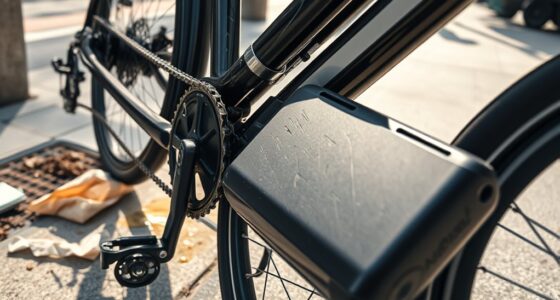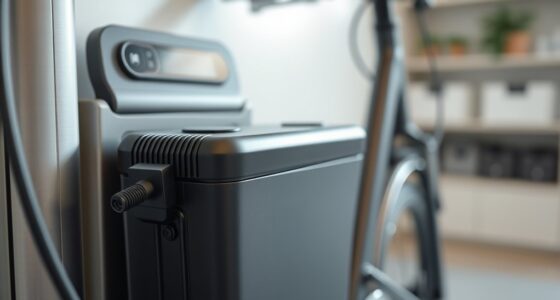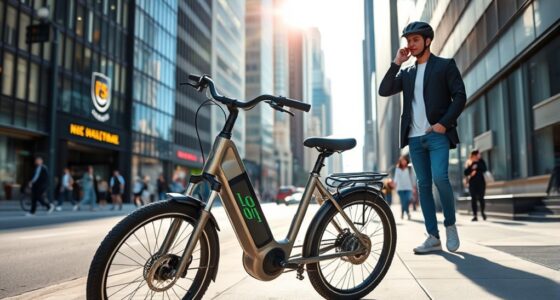To convert your traditional bike into an e-bike, start by selecting a compatible conversion kit with a suitable motor, either hub or mid-drive, based on your riding terrain. Install the battery in a balanced, accessible spot like the rear rack or down tube for stability. Attach the motor to the wheel or bottom bracket, then wire everything securely, ensuring proper connections. With the right setup, you’ll enjoy powered rides—if you keep exploring, you’ll find out how to optimize your e-bike for maximum fun and efficiency.
Key Takeaways
- Choose between hub motor, mid-drive, or friction drive kits based on terrain and bike compatibility.
- Select an appropriate battery placement, such as rear rack or down tube, for balance and handling.
- Ensure the motor and battery are compatible with your bike’s frame and riding needs.
- Follow proper installation procedures for the motor, wiring, and battery to ensure safety and performance.
- Test and fine-tune the system to achieve optimal power, balance, and ride quality.

If you’re looking to upgrade your ride without buying a new bike, converting your traditional bicycle into an e-bike is a practical option. One of the first things you’ll need to decide is where to place the battery. Battery placement is vital because it affects your bike’s balance, weight distribution, and handling. Many conversions place the battery either on the rear rack, integrated into the frame, or on the down tube. Rear rack placement is straightforward and easy to access, but it can make the bike feel rear-heavy. Installing the battery on the down tube keeps the weight low and centralized, offering better stability and a more natural riding experience. Some advanced kits feature integrated batteries that blend seamlessly into the frame, preserving your bike’s original look while maintaining a low center of gravity.
Battery placement impacts bike balance—rear rack, down tube, or integrated options each offer unique advantages.
Next, you’ll want to consider the motor types available for your conversion. There are mainly three options: hub motors, mid-drive motors, and friction drive motors. Hub motors are mounted directly into either the front or rear wheel, making installation simple and quick. They’re ideal for flat terrains and provide a smooth riding experience, but they can add weight to the wheel, affecting handling. Mid-drive motors are positioned near the bottom bracket, engaging the crankshaft. This type offers better weight distribution and efficiency, especially on hilly terrain, since it leverages your bike’s gears. Mid-drive systems tend to be more complex to install but provide a more natural riding feel and better power transfer. Friction drive motors, which contact the tire directly, are less common but can be a quick, inexpensive upgrade for basic needs.
When selecting a motor, think about your typical riding conditions. If you mostly ride on flat roads, hub motors might suffice. For hill climbing or rugged terrain, mid-drive motors are usually more effective. Whichever motor type you choose, verify it’s compatible with your bike’s frame and that the power output matches your riding goals. Additionally, considering the contrast ratio of your e-bike’s motor system can help you understand how well it performs in different lighting and terrain conditions, ensuring you get the best visual clarity and power efficiency during rides.
Installing a conversion kit involves some basic mechanical skills, but all necessary components—battery, motor, controller, and wiring—are usually included. Pay close attention to how you attach the battery, ensuring it’s secure and well-balanced to avoid handling issues. With the right motor type and thoughtful battery placement, you’ll transform your regular bike into a powerful e-bike that makes commuting or leisurely rides more effortless and enjoyable.
Frequently Asked Questions
How Much Does Converting a Bike Typically Cost?
The cost breakdown for converting your bike into an e-bike varies based on parts and labor. Typically, conversion expenses range from $300 to $1,000. You’ll need a kit with a motor, battery, controller, and sensors. Do-it-yourself conversions cost less but require technical skills, while professional installations might be pricier. Consider your budget and desired features to determine the best option for your needs.
Will Converting My Bike Affect Its Warranty?
Imagine this: you’re riding your converted e-bike, feeling like a modern-day knight. You wonder if converting your bike affects its warranty. Warranty implications depend on manufacturer policies; some may void your warranty if you alter the bike, while others might not. Always check with your bike’s manufacturer before converting. Knowing their policies helps you ride confidently without risking your warranty, ensuring your e-bike adventure stays smooth and worry-free.
Is It Legal to Ride a Converted E-Bike on Public Roads?
You can ride a converted e-bike on public roads, but you must follow electric motor regulations that vary by location. Make sure your bike meets conversion safety standards, such as motor power limits and speed restrictions, to stay legal. Check local laws to ensure compliance, as some areas have specific rules for e-bikes. Staying informed about electric motor regulations helps you enjoy riding safely and legally.
How Long Does the Conversion Process Usually Take?
Like a clock ticking in a bygone era, the conversion process can take anywhere from a few hours to a full day, depending on your skills. You’ll need to guarantee battery compatibility and proper motor integration, which are key to a smooth upgrade. If you’re handy, expect quicker results; if not, it might take longer. Planning ahead helps, but most conversions are doable within a weekend.
Can I Convert Any Type of Traditional Bike Into an E-Bike?
You can convert many traditional bikes into e-bikes, but bike frame compatibility is key. Not all frames support motor or battery integration, especially smaller or unique designs. Check if your bike’s frame can accommodate the motor kit and battery. If it’s compatible, you’ll find it easier to install the components without compromising the bike’s structure. Always verify the conversion kit matches your bike’s specifications for a safe, effective upgrade.
Conclusion
Converting your traditional bike into an e-bike is a smart way to upgrade your ride without breaking the bank. With a little effort, you can enjoy the modern convenience of pedal-assisted power, making commutes or leisurely rides more enjoyable. Think of it as your very own steampunk invention—blending old-world charm with new-world tech. So, gear up and embrace this DIY adventure; your new e-bike will have you whizzing through the streets faster than a chariot from the Renaissance!









